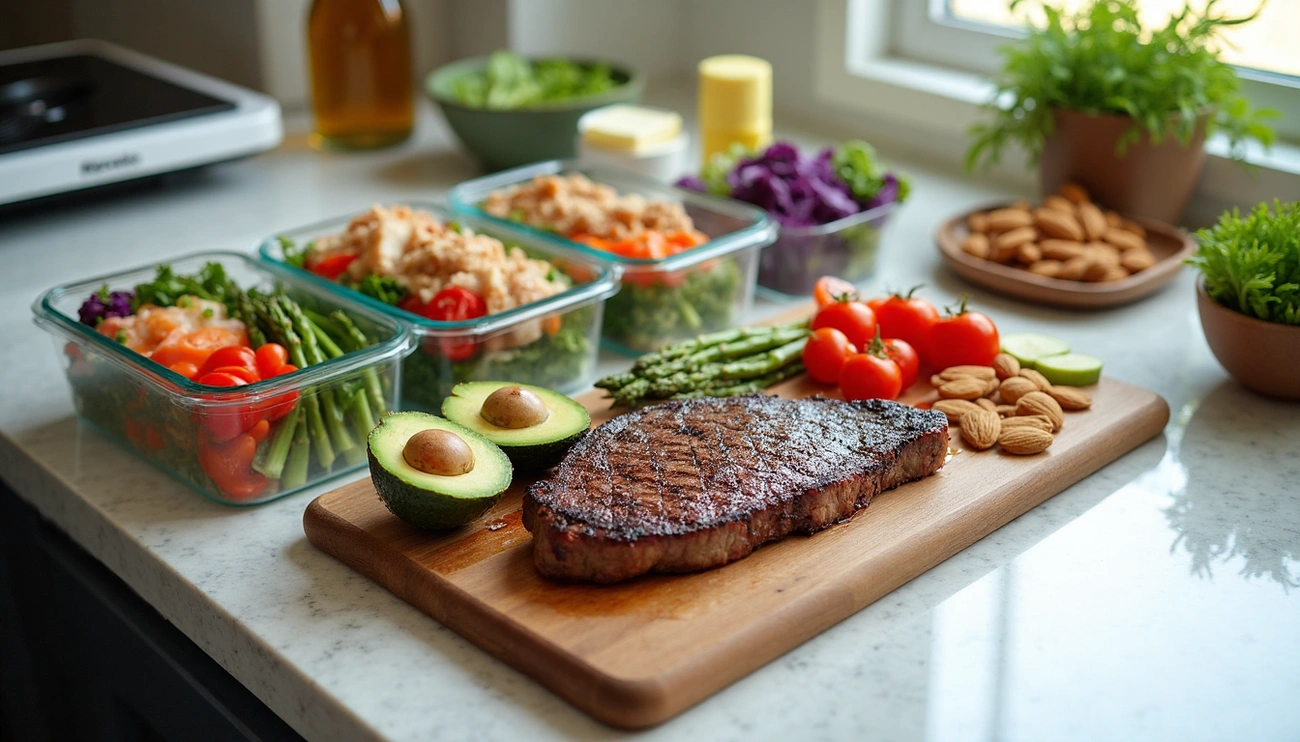Everyone talks about keto these days. For good reason. It works.
The basic breakdown is simple. Your daily calories come from 70-80% fat, 20-25% protein, and just 5-10% carbs. I keep my carbs under 50 grams daily to stay in ketosis. That’s it.
Starting keto feels overwhelming at first. You track macros carefully to get into ketosis. Results show up fast though. I lost weight the first week. Research backs this up too – better blood pressure, lower triglycerides, improved cholesterol when you stick with it.
Here’s what I actually eat. Real meals from my kitchen. Seven days of exactly what worked for me. No fancy ingredients or complicated recipes. Just food that keeps me in ketosis and gets results.
How I Got Started with Keto (and Why It Worked for Me)
I struggled with weight most of my life. Tried every diet out there. None stuck. That’s when I found keto – high fat, moderate protein, extremely low carb eating.
My goals before starting keto
Weight loss was the obvious goal. I ended up losing over 50 pounds. But I wanted more than just a number on the scale.
I needed sustainable eating habits. Real energy throughout the day. Food that actually tasted good without feeling deprived. I spent weeks reading Gary Taubes and Robert Lustig before starting. Had to know this would work long-term.
My main goal was finding something I could stick with. Not another temporary fix.
Initial challenges and how I overcame them
First two weeks were rough. Keto flu hit hard – headaches, nausea, brain fog, the works.
I kept it simple with four strategies:
- Set a clear goal – 10 pounds in four weeks
- Plan everything – researched for weeks before starting
- Find support – got a friend who’d done keto to help
- Focus on carbs first – worried about other macros later
Hydration became crucial. Keto makes you lose water fast. I salted everything and ate lots of leafy greens and avocados for electrolytes.
Sleep mattered more than I expected. Poor sleep makes keto flu worse. I also backed off intense workouts until my body adapted.
How I calculated my macros
Used an online keto calculator for my targets. It figured out my basal metabolic rate using the Mifflin-St.Jeor Formula.
Then it calculated my total daily energy expenditure based on activity level. I set a 10-20% calorie deficit for steady weight loss.
For protein, I based it on lean body mass, not total weight. At 0.8g per pound since I was moderately active. This preserved muscle while losing fat.
Carbs stayed under 20g daily to guarantee ketosis. Fat intake I didn’t stress about – just ate enough to feel satisfied within my calorie limit.
This approach worked. Real results in weight loss and overall health.
What I Eat on a Typical Day
Image Source: Everyday Health
My daily keto eating follows a simple pattern. High fat, moderate protein, very low carbs. Here’s what actually ends up on my plate.
Breakfast: My go-to high-fat start
Two eggs fried in butter with sautéed greens works every time. Simple but keeps me full until lunch. For me, this beats complicated breakfast recipes.
Busy mornings call for a mushroom omelet with full-fat cheese. Sometimes I stuff bell peppers with eggs and cheese or add nuts to full-fat yogurt. Quick and satisfying.
Lunch: Easy meals that keep me full
Bunless burger with cheese, mushrooms, and avocado over leafy greens is my standard. Plenty of fat, almost zero carbs. It works.
I rotate between tuna salad with celery on greens or arugula salad with hard-boiled eggs, turkey, avocado, and blue cheese. No afternoon crashes with these meals.
Dinner: Balanced and satisfying
Grilled salmon with spinach sautéed in sesame oil happens a lot. Also roast chicken with cream sauce and broccoli, or pork chops with green beans in olive oil.
Sometimes I make bison steak with cheesy broccoli or meatballs with zucchini noodles and Parmesan. For me, variety prevents boredom.
Snacks: What I reach for between meals
Almonds and cheddar cheese, half an avocado stuffed with chicken salad, or guacamole with celery. These keep me going without breaking ketosis.
Olives with salami, hard-boiled eggs, coconut chips, or berries with heavy cream work too. I keep carbs under 5g per snack.
Drinks: Staying hydrated and keto-friendly
Water is my main drink. Coffee with heavy cream or sparkling water with lemon for variety.
Green tea gives me antioxidants and gentle caffeine. After workouts, I add a pinch of salt to water or use sugar-free electrolyte drinks.
Socializing means dry red wine or low-carb beer occasionally. I avoid sugary drinks completely – regular sodas pack 41 grams of carbs.
This eating pattern became automatic after a few weeks. No restrictions, just smart choices that keep me in ketosis.
My 7-Day Keto Meal Plan (With Real Examples)
Image Source: Whole Foods Market
Here’s my actual week of eating. Real meals that kept me in ketosis and delivered results. Each day stays under 50g net carbs.
Day 1: Simple and clean start
Keep it basic when starting. Eggs fried in butter with sautéed greens for breakfast. Bunless burger with cheese and avocado over greens for lunch. Baked salmon with asparagus for dinner. About 1,836 calories total – 108g protein, 56g carbs, 136g fat. I snack on celery with almond butter. Simple but satisfying.
Day 2: Adding variety with seafood
Day two I mix things up. California veggie omelet for breakfast (323 calories). Taco salad with ground turkey, sour cream, cheese for lunch (546 calories). Three-cheese spinach casserole for dinner (250 calories). Total comes to 1,912 calories – 111g protein, 44g carbs, 146g fat. I keep that 70% fat ratio.
Day 3: Midweek comfort meals
Comfort food helps midweek. Breakfast sausage and eggs to start. Zucchini noodles with meatballs for lunch. Grilled chicken and broccoli for dinner. Around 1,824 calories – 105g protein, 54g carbs, 138g fat. For snacks, I do half an avocado with everything bagel seasoning. Hits the spot.
Day 4: Quick meals for busy days
Busy days need fast options. Coconut almond butter smoothie for breakfast (780 calories). Tuna salad with avocado mayo for lunch. Sirloin steak with green beans for dinner. Despite rushing around, I get 1,977 calories – 104g protein, 41g carbs, 163g fat. Works when time is tight.
Day 5: High-fat, low-effort meals
I focus on higher fat with minimal work. Greek yogurt with nuts and cinnamon for breakfast. Simple bacon and eggs for lunch. Shrimp with zucchini noodles for dinner. Easy meals give me 1,756 calories – 111g protein, 54g carbs, 128g fat. Perfect for lazy days.
Day 6: Weekend-friendly dishes
Weekends I can cook more. Hard-boiled eggs with nuts for breakfast. Hearty cobb salad with chicken, eggs, bacon and blue cheese for lunch (614 calories). Stuffed peppers for dinner. Day totals 1,984 calories – 119g protein, 53g carbs, 147g fat. I enjoy the extra cooking time.
Day 7: Reset and prep for next week
Sundays are for resetting. Over-easy eggs with bacon for breakfast. Protein shake midday. Leftover stuffed peppers for lunch. Spinach lasagna using zucchini instead of pasta with grilled chicken for dinner. About 2,039 calories – 125g protein, 57g carbs, 152g fat. I also make keto ice cream with coconut milk and dark chocolate. Sunday treat.
I keep net carbs around 20g daily. Stays in ketosis without feeling restricted. These meals actually taste good.
How I Shop and Prep for the Week
Planning makes all the difference. I learned this the hard way after impulse buying kicked me out of ketosis.
My keto grocery list essentials
I shop in four categories: proteins, vegetables, fats, and pantry items. Eggs, chicken, grass-fed beef, and fatty fish are my protein staples – zero carbs naturally. For vegetables, I stick with broccoli, leafy greens, and zucchini. Most above-ground vegetables work great.
Fats are where I load up. Avocados, butter, olive oil, and macadamia nuts fill my cart. My pantry gets almond flour, coconut flour, keto sweeteners, and sugar-free dark chocolate for treats.
Before I shop, I check what’s already in my kitchen. Prevents waste and duplicate purchases.
Batch cooking tips that save time
I use two approaches: Sunday meal prep or doubling recipes when I cook. Sundays work best – I prep proteins, chop vegetables, and make sauces all at once.
Everything organized before cooking saves me hours. I call it “mise en place”. Pre-wash vegetables, marinate proteins, prep sauces ahead of time. I make large batches of shredded chicken. Uses it all week long.
How I store and portion meals
Glass containers for this week’s meals. Freezer bags for longer storage. I label everything – meal name, prep date, expiration date.
Individual portions work better. Refreezing ruins the quality. For casseroles, I line the dish with parchment, freeze, then cut portions. Remove air from bags and containers. Prevents freezer burn.
What Changed for Me (Results After 3 Months)
Image Source: YouTube
Three months in, the results speak for themselves.
Weight loss and body changes
Lost 15 pounds. That’s about 10% of my body weight. My waistline shrunk by 11%. Clothes got loose fast – always a good sign.
Body fat dropped 12.4%. Real change, not just water weight.
My bloodwork improved too. HDL jumped to 91, triglycerides fell to 48. Total cholesterol to HDL ratio hit 2.7. Despite eating more fat, my heart markers got better.
Energy and mental clarity
No more afternoon crashes. Used to need caffeine to function. Now I have steady energy all day.
Sleep changed too. Only need 6-7 hours instead of 8-9. Wake up refreshed.
Mental fog cleared up. Less anxiety, better mood. Research backs this up – keto helps with brain function.
What I learned
Most of my eating was habit, not hunger. I wasn’t actually hungry as much as I thought.
One bad meal won’t kill progress. String together several bad meals and you’re in trouble. That balance matters.
Consistency beats perfection. Stick with it and results follow.
FAQs
Q1. What are the basic principles of a keto diet?
A keto diet typically consists of 70-80% fat, 20-25% protein, and 5-10% carbohydrates. Most people need to limit carbs to under 50 grams per day to maintain ketosis, a metabolic state where the body burns fat for fuel instead of carbohydrates.
Q2. How long does it take to see results on a keto diet?
Many people experience initial weight loss within the first week of starting a keto diet. However, significant and sustainable results are often seen after about 3 months of consistent adherence to the diet, including improvements in weight, body composition, and energy levels.
Q3. What are some common challenges when starting a keto diet?
Initial challenges can include the “keto flu” (headaches, nausea, irritability, weakness, and brain fog), which typically occurs in the first two weeks. Proper hydration, electrolyte replacement, and gradually reducing carbs can help overcome these symptoms.
Q4. Can you provide examples of keto-friendly meals?
Keto-friendly meals include eggs fried in butter with sautéed greens for breakfast, a bunless burger with cheese and avocado over mixed greens for lunch, and grilled salmon with asparagus for dinner. Snacks can include nuts, cheese, and low-carb vegetables with dips like guacamole.
Q5. How do you maintain ketosis while dining out or socializing?
When dining out, focus on protein-based dishes with non-starchy vegetables, and ask for substitutions for high-carb sides. For socializing, opt for low-carb alcoholic beverages in moderation, such as dry red wine or low-carb beer. Always prioritize water for hydration and avoid sugary drinks.

